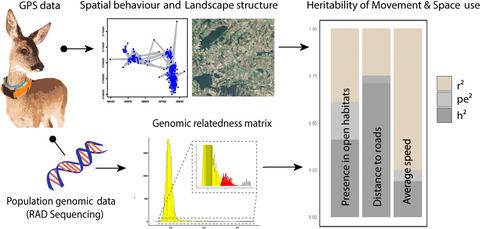当前位置:
X-MOL 学术
›
J. Evol. Biol.
›
论文详情
Our official English website, www.x-mol.net, welcomes your feedback! (Note: you will need to create a separate account there.)
Pedigree‐free quantitative genetic approach provides evidence for heritability of movement tactics in wild roe deer
Journal of Evolutionary Biology ( IF 2.1 ) Pub Date : 2020-02-07 , DOI: 10.1111/jeb.13594 Laura Gervais 1, 2, 3 , Aidan J M Hewison 1, 2 , Nicolas Morellet 1, 2 , Maria Bernard 4, 5 , Joël Merlet 1, 2 , Bruno Cargnelutti 1, 2 , Yannick Chaval 1, 2 , Benoit Pujol 3, 6 , Erwan Quéméré 1, 2, 7
Journal of Evolutionary Biology ( IF 2.1 ) Pub Date : 2020-02-07 , DOI: 10.1111/jeb.13594 Laura Gervais 1, 2, 3 , Aidan J M Hewison 1, 2 , Nicolas Morellet 1, 2 , Maria Bernard 4, 5 , Joël Merlet 1, 2 , Bruno Cargnelutti 1, 2 , Yannick Chaval 1, 2 , Benoit Pujol 3, 6 , Erwan Quéméré 1, 2, 7
Affiliation

|
Assessing the evolutionary potential of animal populations in the wild is crucial to understanding how they may respond to selection mediated by rapid environmental change (e.g. habitat loss and fragmentation). A growing number of studies have investigated the adaptive role of behaviour, but assessments of its genetic basis in a natural setting remain scarce. We combined intensive biologging technology with genome‐wide data and a pedigree‐free quantitative genetic approach to quantify repeatability, heritability and evolvability for a suite of behaviours related to the risk avoidance‐resource acquisition trade‐off in a wild roe deer (Capreolus capreolus) population inhabiting a heterogeneous, human‐dominated landscape. These traits, linked to the stress response, movement and space‐use behaviour, were all moderately to highly repeatable. Furthermore, the repeatable among‐individual component of variation in these traits was partly due to additive genetic variance, with heritability estimates ranging from 0.21 ± 0.08 to 0.70 ± 0.11 and evolvability ranging from 1.1% to 4.3%. Changes in the trait mean can therefore occur under hypothetical directional selection over just a few generations. To the best of our knowledge, this is the first empirical demonstration of additive genetic variation in space‐use behaviour in a free‐ranging population based on genomic relatedness data. We conclude that wild animal populations may have the potential to adjust their spatial behaviour to human‐driven environmental modifications through microevolutionary change.
中文翻译:

无谱系定量遗传方法为野生狍运动策略的遗传性提供了证据
评估野生动物种群的进化潜力对于了解它们如何应对由快速环境变化(例如栖息地丧失和破碎化)介导的选择至关重要。越来越多的研究调查了行为的适应性作用,但对其在自然环境中的遗传基础的评估仍然很少。我们将密集的生物记录技术与全基因组数据和无谱系的定量遗传方法相结合,以量化与野生狍 (Capreolus capreolus) 的一系列与风险规避-资源获取权衡相关的行为的可重复性、遗传性和可进化性居住在人类主导的异质景观中的人口。这些与压力反应、运动和空间使用行为相关的特征都是中等至高度可重复的。此外,这些性状变异的个体间可重复成分部分是由于加性遗传变异,遗传力估计范围为 0.21 ± 0.08 至 0.70 ± 0.11,进化率范围为 1.1% 至 4.3%。因此,在假设的定向选择下,只需几代就可以发生性状均值的变化。据我们所知,这是基于基因组相关性数据的自由放养种群空间使用行为的加性遗传变异的首次实证证明。我们得出的结论是,野生动物种群可能有潜力通过微进化变化来调整它们的空间行为以适应人类驱动的环境变化。遗传力估计范围为 0.21 ± 0.08 至 0.70 ± 0.11,进化率范围为 1.1% 至 4.3%。因此,在假设的定向选择下,只需几代就可以发生性状均值的变化。据我们所知,这是基于基因组相关性数据的自由放养种群空间使用行为的加性遗传变异的首次实证证明。我们得出的结论是,野生动物种群可能有潜力通过微进化变化来调整它们的空间行为以适应人类驱动的环境变化。遗传力估计范围为 0.21 ± 0.08 至 0.70 ± 0.11,进化率范围为 1.1% 至 4.3%。因此,在假设的定向选择下,只需几代就可以发生性状均值的变化。据我们所知,这是基于基因组相关性数据的自由放养种群空间使用行为的加性遗传变异的首次实证证明。我们得出的结论是,野生动物种群可能有潜力通过微进化变化来调整它们的空间行为以适应人类驱动的环境变化。这是基于基因组相关性数据的自由放养种群空间使用行为的加性遗传变异的首次实证证明。我们得出的结论是,野生动物种群可能有潜力通过微进化变化来调整它们的空间行为以适应人类驱动的环境变化。这是基于基因组相关性数据的自由放养种群空间使用行为的加性遗传变异的首次实证证明。我们得出的结论是,野生动物种群可能有潜力通过微进化变化来调整它们的空间行为以适应人类驱动的环境变化。
更新日期:2020-02-07
中文翻译:

无谱系定量遗传方法为野生狍运动策略的遗传性提供了证据
评估野生动物种群的进化潜力对于了解它们如何应对由快速环境变化(例如栖息地丧失和破碎化)介导的选择至关重要。越来越多的研究调查了行为的适应性作用,但对其在自然环境中的遗传基础的评估仍然很少。我们将密集的生物记录技术与全基因组数据和无谱系的定量遗传方法相结合,以量化与野生狍 (Capreolus capreolus) 的一系列与风险规避-资源获取权衡相关的行为的可重复性、遗传性和可进化性居住在人类主导的异质景观中的人口。这些与压力反应、运动和空间使用行为相关的特征都是中等至高度可重复的。此外,这些性状变异的个体间可重复成分部分是由于加性遗传变异,遗传力估计范围为 0.21 ± 0.08 至 0.70 ± 0.11,进化率范围为 1.1% 至 4.3%。因此,在假设的定向选择下,只需几代就可以发生性状均值的变化。据我们所知,这是基于基因组相关性数据的自由放养种群空间使用行为的加性遗传变异的首次实证证明。我们得出的结论是,野生动物种群可能有潜力通过微进化变化来调整它们的空间行为以适应人类驱动的环境变化。遗传力估计范围为 0.21 ± 0.08 至 0.70 ± 0.11,进化率范围为 1.1% 至 4.3%。因此,在假设的定向选择下,只需几代就可以发生性状均值的变化。据我们所知,这是基于基因组相关性数据的自由放养种群空间使用行为的加性遗传变异的首次实证证明。我们得出的结论是,野生动物种群可能有潜力通过微进化变化来调整它们的空间行为以适应人类驱动的环境变化。遗传力估计范围为 0.21 ± 0.08 至 0.70 ± 0.11,进化率范围为 1.1% 至 4.3%。因此,在假设的定向选择下,只需几代就可以发生性状均值的变化。据我们所知,这是基于基因组相关性数据的自由放养种群空间使用行为的加性遗传变异的首次实证证明。我们得出的结论是,野生动物种群可能有潜力通过微进化变化来调整它们的空间行为以适应人类驱动的环境变化。这是基于基因组相关性数据的自由放养种群空间使用行为的加性遗传变异的首次实证证明。我们得出的结论是,野生动物种群可能有潜力通过微进化变化来调整它们的空间行为以适应人类驱动的环境变化。这是基于基因组相关性数据的自由放养种群空间使用行为的加性遗传变异的首次实证证明。我们得出的结论是,野生动物种群可能有潜力通过微进化变化来调整它们的空间行为以适应人类驱动的环境变化。


























 京公网安备 11010802027423号
京公网安备 11010802027423号